
Aerial roots are roots growing above the ground. They are often adventitious, i.e. formed from nonroot tissue. They are found in diverse plant species, including epiphytes such as orchids (Orchidaceae), tropical coastal swamp trees such as mangroves, banyan figs, the warm-temperate rainforest rata, and pohutukawa trees of New Zealand. Vines such as common ivy and poison ivy also have aerial roots.
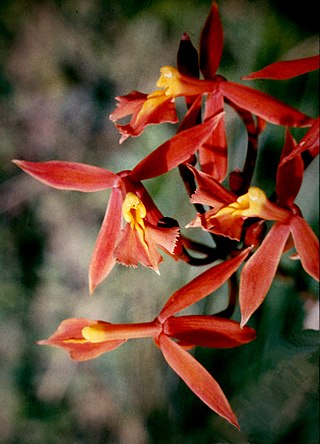
Epidendroideae is a subfamily of plants in the orchid family, Orchidaceae. Epidendroideae is larger than all the other orchid subfamilies together, comprising more than 15,000 species in 576 genera. Most epidendroid orchids are tropical epiphytes, typically with pseudobulbs. There are, however, some terrestrials such as Epipactis and even a few myco-heterotrophs, which are parasitic upon mycorrhizal fungi.

Lejeuneaceae is the largest family of liverworts. Most of its members are epiphytes found in the tropics, while others can be found in temperate regions.

Nothofagus cunninghamii, commonly known as myrtle beech or Tasmanian myrtle, is the dominant species of cool temperate rainforests in Tasmania and Southern Victoria. It has low fire resistance and grows best in partial shade conditions.

Acer circinatum, or vine maple, is a species of maple native to northwestern North America. Vine maple typically grows as a low-elevation coastal tree in temperate areas of high precipitation such as the west coast of Oregon and northern California, as well as the temperate rainforests of Washington and British Columbia. Vine maples play an important role in conserving the biodiversity of lowland ecosystems by enriching upper soil layers and providing habitat for other organisms.
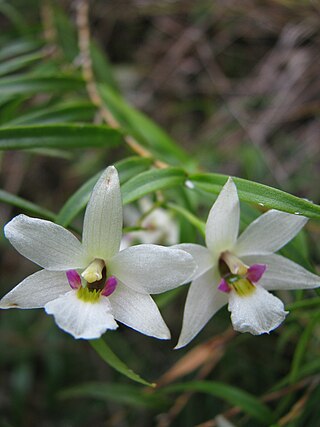
Dendrobium cunninghamii, commonly known as winika, pekapeka, Christmas orchid, bamboo orchid or ladies slipper orchid, is a species of epiphytic orchids that is endemic to New Zealand. It is commonly found growing in rainforest in the North, South, Stewart and Chatham Islands and normally flowers in summer and early autumn.
Fulfordianthus evansii is a species of liverwort in the family Lejeuneaceae. It is found in Belize, Costa Rica, Guatemala, and Panama. Its natural habitat is subtropical or tropical moist lowland forests.
Radula jonesii is a species of liverwort in the family Radulaceae, first described in 1988 from specimens collected in the Anaga Mountains of Tenerife. Endemic to Macaronesia, this dark to olive-green liverwort is known from five locations on Madeira Island and one location on Tenerife, where it grows as both an epiphyte on trees such as Laurus novocanariensis and as a lithophyte on shaded rocks in old growth laurel forest ecosystems between 800–1,000 m (2,600–3,300 ft) altitude. The species is distinguished by its procumbent growth habit, pinnately branched stems measuring 10–15 mm (0.4–0.6 in) in length, and distinctive cellular features including uniformly thin-walled leaf cells. Classified as Endangered due to its restricted range and small population size, R. jonesii faces threats from climate change, habitat degradation, and tourism pressure, though its habitat receives protection through various conservation designations including UNESCO World Heritage status.

Radula is a genus of liverwort, and is the only genus in family Radulaceae.

Crepidium, commonly known as 沼兰属 or spur orchids is a genus of about three hundred species of orchids in the family Orchidaceae. Plants in this genus are evergreen, mostly terrestrial plants with short stems lying on the ground, two or more relatively large, pleated leaves and small, non-resupinate flowers with spreading sepals and petals. The genus is widely distributed in the tropics.
This glossary of botanical terms is a list of definitions of terms and concepts relevant to botany and plants in general. Terms of plant morphology are included here as well as at the more specific Glossary of plant morphology and Glossary of leaf morphology. For other related terms, see Glossary of phytopathology, Glossary of lichen terms, and List of Latin and Greek words commonly used in systematic names.

Acriopsis emarginata, commonly known as the pale chandelier orchid, is a species of orchid endemic to Queensland. It is a clump-forming epiphyte with dark green leaves and curved, branching flower stems with many white and cream-coloured flowers.
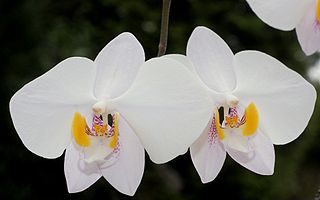
Phalaenopsis philippinensis is an endemic species of orchid found from Luzon island in the Philippines.
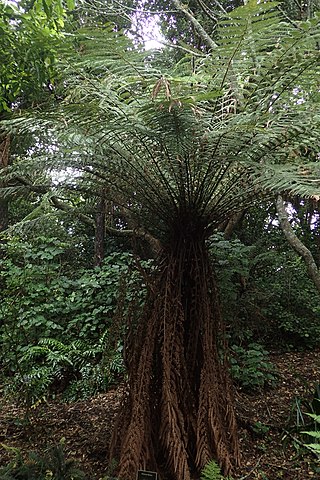
Dicksonia fibrosa, the golden tree fern, whekī-ponga, wheki-kōnga, or kurīpākā is a species of medium-sized tree fern native to New Zealand.

Lejeunea hodgsoniana is a species of liverwort in the family Lejeuneaceae. Endemic to New Zealand, it was first recognized in 1980 but not formally described until 2013. The plant forms bright green mats up to 7 centimetres in diameter on tree bark and occasionally on rocks. The species is found from the Kermadec Islands in the north to the Chatham Islands in the south, primarily in coastal and lowland areas below 100 metres elevation. It is distinguished from related species by its relatively large size, multi-celled tooth on the leaf lobule, and deeply divided underleaves with pointed tips. While showing a particular affinity for mahoe trees, it grows on various native and introduced trees and is considered "Not Threatened" under the New Zealand Threat Classification System due to its abundance within its range and ability to grow in both pristine and disturbed habitats.
Radula perrottetii is a species of plant in genus Radula, a genus of liverworts. It is endemic in Japan. It contains the small molecule perrottetinene a cannabinoid and other secondary metabolites of scientific interest including marchantin A.
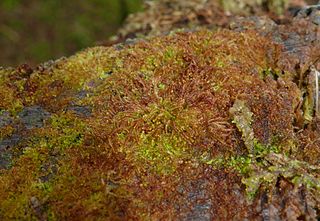
Nowellia curvifolia is a species of liverwort belonging to the family Cephaloziaceae. It is a small, delicate plant that forms prostrate growths on rotting logs in forests throughout the northern temperate and subarctic regions. The species is distinguished by its distinctive billowed leaves arranged in two rows, each divided into two pointed lobes with the lower lobe forming a specialised water-holding pocket called a water-sac. The plant shows seasonal colour variation from rose to purple to brown to spring green, developing reddish-purple pigmentation in autumn and winter. It reproduces both sexually, through spores produced in reddish-brown capsules, and asexually via single-celled gemmae. N. curvifolia serves as an indicator species in forest ecosystems, particularly in montane spruce-fir forests, where it often forms pure mats on decorticated logs and is associated with the slime mould species Barbeyella minutissima.
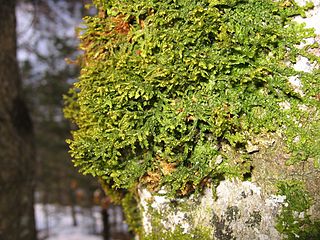
Porella platyphylla is a species of liverwort belonging to the family Porellaceae. It has a Holarctic distribution, occurring across Eurasia and North America, where it typically grows on tree bark and rocks in areas with adequate rainfall. The species is most common in regions receiving at least 600 millimetres of annual precipitation. The species forms part of a complex taxonomic group that includes several closely related species and hybrids, with populations showing distinct genetic differences between continents despite their morphological similarity.
Rachelia is a monotypic genus of flowering plants belonging to the family Asteraceae. It just contains one species, Rachelia glariaJ.M.Ward & Breitw. It is in the tribe Gnaphalieae.
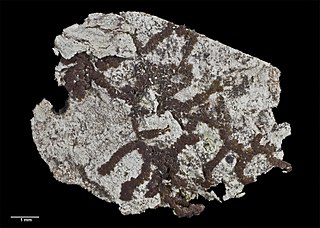
Frullania wairua, the spirit liverwort or radar bush liverwort, is a species of liverwort in the order Porellales. It is one of 24 species in the large genus Frullania that are native to New Zealand. The species was first described by Matt von Konrat and John E. Braggins in 2005 in the New Zealand Journal of Botany.















